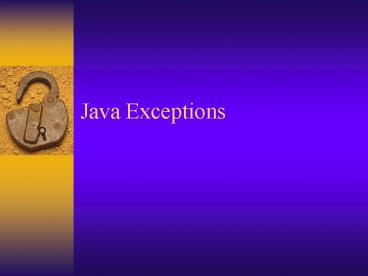Java Exceptions - PowerPoint PPT Presentation
1 / 16
Title:
Java Exceptions
Description:
Java Exceptions Intro to Exceptions What are exceptions? Events that occur during the execution of a program that interrupt the normal flow of control. – PowerPoint PPT presentation
Number of Views:102
Avg rating:3.0/5.0
Title: Java Exceptions
1
Java Exceptions
2
Intro to Exceptions
- What are exceptions?
- Events that occur during the execution of a
program that interrupt the normal flow of
control. - One technique for handling Exceptions is to use
return statements in method calls. - This is fine, but java provides a much more
general and flexible formalism that forces
programmers to consider exceptional cases.
3
Exception Class hierarchy
Object
- must handle
- may handle
- too serious to catch
Throwable
Error
Exception
RuntimeException
many
NullPointerException
IndexOutOfBounds
4
Catch orSpecify requirement
- Most Exceptions in Java are subject to the
so-called catch or specify requirement. - That is, to call a method that is declared to
throw an Exception, one must explicitly wrap the
call in a try block - try
- File f new File(foo.txt)
- Catch(FileNotFoundException fnfe)
- or one must specify the Exception in the method
signature where the method call appears - public void foo() throws
FileNotFoundException
5
Three kinds of Exceptions
- I say most on previous slide because there are
three different type of exeptions in Java and
only one is subject to catch or specify - Checked Exceptions Must handle
- Runtime Exceptions May handle
- Errors May handle
- Each of these types is represented by its own
class in the Throwable hierarchy.
6
Exception Handling Basics
- Three parts to Exception handling
- 1. claiming exception
- 2. throwing exception
- 3. catching exception
- A method has the option of throwing one or more
exceptions when specified conditions occur. This
exception must be claimed by the method. Another
method calling this method must either catch or
rethrow the exception. (unless it is a
RuntimeException)
7
Claiming Exceptions
- Method declaration must specify every exception
that the method potentially throws - MethodDeclaration throws Exception1,
Exception2, ..., ExceptionN - Exceptions themselves are concrete subclasses of
Throwable and must be defined and locatable in
regular way.
8
Throwing Exception
- To throw an Exception, use the throw keyword
followed by an instance of the Exception class - void foo() throws SomeException
- if (whatever) ...
- else throw new SomeException(...)
- Well talk about passing data via the Exception
constructor soon. - Note that if a method foo has a throw clause
within it, that the Exception that is thrown (or
one of its superclasses) must be claimed after
the signature.
9
Catching Exceptions
- The third piece of the picture is catching
exceptions. - This is what you will do with most commonly,
since many of javas library methods are defined
to throw one or more runtime exception. - Catching exceptions
- When a method is called that throws and Exception
e.g SomeException, it must be called in a
try-catch block - try
- foo()
- catch(SomeException se)...
10
Catching Exceptions, cont.
- Note that if a method throws an Exception that is
NOT a RuntimeException, you must do one of two
things - try-catch it (often called handling it)
- rethrow it
- In the latter case, responsibility then moves up
the calling chain to handle it, and so on all the
way up to main.
11
More on try-catch
The general form of the try-catch structure is
try / any number of lines of code
that call any number of methods with any
thrown Exceptions / catch(Exception1
e1) / do anything you want here
e.g. change value and try again. print
error and quit print stacktrace
/ catch (Exception2 e2) / any number
of exceptions can be handled ... /
12
Example1
import java.io. public class Exception1
public static void main(String args)
InputStream f try f new
FileInputStream("foo.txt")
catch(FileNotFoundException fnfe)
System.out.println(fnfe.getMessage())
13
Example2
import java.io. public class Exception2
public static void main(String args)
InputStream fin try fin new
FileInputStream("foo.txt") int input
fin.read() catch(FileNotFoundExce
ption fnfe) System.out.println(fnfe.g
etMessage()) catch(IOException
ioe) System.out.println(ioe.getMessag
e())
14
import java.io. public class Exception2
public static void main(String args)
InputStream fin try fin new
FileInputStream("foo.txt") int input
fin.read()
catch(FileNotFoundException fnfe)
System.out.println(fnfe.getMessage())
catch(IOException ioe)
System.out.println(ioe.getMessage())
15
Recommendations
- Do not use Exceptions to handle normal conditions
in the program that can be checked with if
statements. For example - to find the end of an array
- to check if an object is null
- See other commented examples in course notes.
16
Creating your own Exceptions
- You can follow this procedure exactly when
creating your own Exception. - Create a class that subclasses Exception (or
RuntimeException). - You may also add functionality so that a relevant
message is stored when the error is thrown, and
any other customized functionality you choose.































